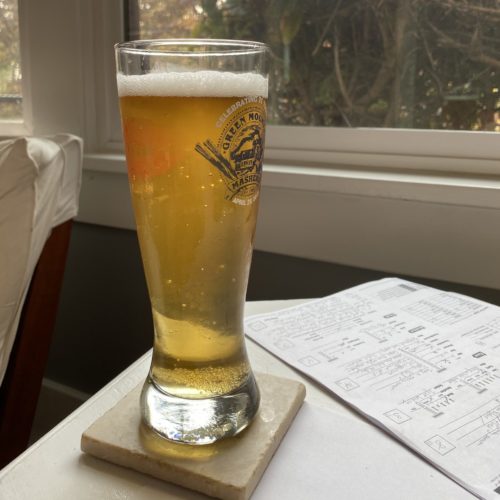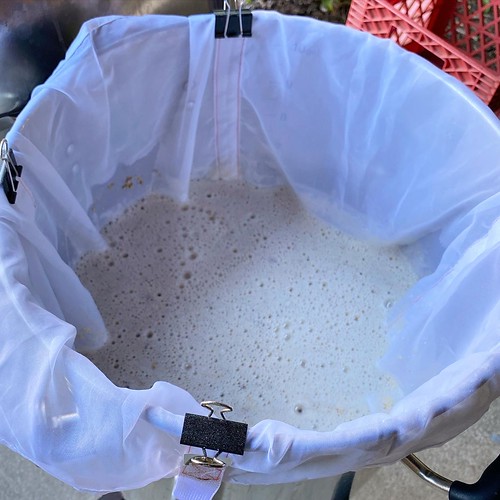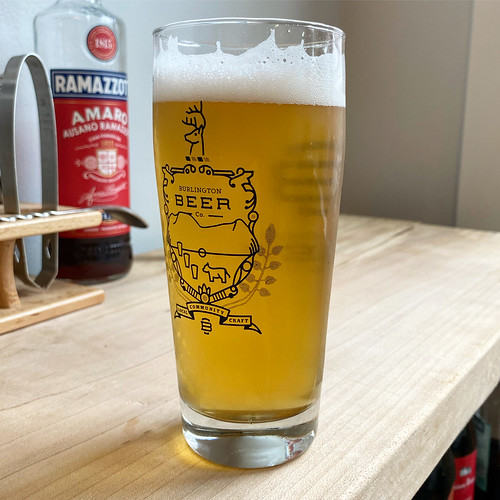Homebrew #105: Horst
¶ by Rob FrieselSeems fitting that while we have a wildfire-smoke-hazy / practically opaque sky here in Seattle, that I should do the write-up for one of my clearest-ever beers — a Munich Helles that I’m calling Horst:

Horst was the name of my German-born grandfather, and though my memories tell me that he was more of a Martini and/or wine-drinker, I suspect that the Munich Helles would have been his beer of choice. 1
With him in mind, I decided to take the bait that every lager-brewing homebrewer eventually takes: Can I make a decent Helles?
Brew Day
I tinkered around with a couple of recipes, trying to keep it simple (Helles!) but to give a little extra malt-flavor punch without going full decoction (lazy!) — and otherwise chose a mash scheduled based on Give ’em Helles. Feeling satisfied with that, and having cultured up a pretty large starter… 2 OFF WE GO!

I mashed in at 148.5 ºF for my first rest. Then… alas! Somehow my pH meter was reading 4.55 which… yikes that’s low. 3 After 45 minutes, give it the second infusion to bring it up to 157.9 ºF and let it rest for another 30 minutes. And then another boiling water infusion for the mash-out.
Pull the bag and squeeze. Kettle receives 7.5 gallons at 9 ºBx (which… 1.037?)
Flame on for boiling. Ninety minutes. One and one-quarter ounce of Hallertauer Mittelfrüh at 90 4 and then the remaining ¾ oz. at flame-out.

Chill it as much and as fast as my little immersion chiller can manage, then run off just over 5 gal. into the carboy at an O.G. of 1.050.

Get it into the fermentation chamber and set that for 52±1 ºF to help it get the rest of the way down to pitching temperatures.

Anyway… some of the clearest wort I’ve ever produced.

Fermentation
Once the wort was chilled below 52 ºF, I decanted the supernatant off the starter and pitched approx. 500 ml of slurry.
By about +12 hours, a krausen was starting to form and bubbles were definitely happening in the blow-off bucket. There was a bit of sulfur aroma off-gassing, but nothing that hasn’t caught my nose early in a lager fermentation.
After two solid weeks at 52±1 ºF, I drew off a sample for gravity and sighted it at 1.010 — also looking pretty darn clear.

At this point, I racked it to a keg, put it on-gas, and let it lager for a month before my patience ran out and I just had to subject myself to an early first pour.

Which was just fine by me.
Overall Impressions
It’s recognizably a German lager. Smooth and round and malty. Would likely fare well in competition if submitted as a 4A. Munich Helles, though somewhat stronger than it ought to be. I like it just fine.

AROMA. Medium-low malt impressions: mostly grainy-sweet with some toasty background notes. Moderate spicy/floral hop character. Fermentation seems clean; very low sulfur note, but no other significant off-aromas.
APPEARANCE. Pale gold color. Very clear, falling just short of brilliant. White head pours tall and persists for quite some time, eventually collapsing into a substantial cordon. Tightly beaded foam while the head stands. Many visible bubbles.
FLAVOR. Leads with medium malt elements that follow aroma: Pils-like grainy-sweet, accompanied by mild toastiness. (Seems slightly muted? Background papery note suggests some oxidation.) Moderate spicy/floral hop impression. Firm, supportive bitterness. No significant fermentation character; light retronasal sulfur, but otherwise no detectable fermentation faults. Balance is decidedly malty. Finishes dry, and while not crisp, it is crisper than the “soft” impression expected in a well-executed take on this style.
MOUTHFEEL. Medium body. Medium carbonation. At-threshold detectable alcohol warming, but not significant. No creaminess. Very low astringency — detectable, but doesn’t distract.
OVERALL IMPRESSION. Very good example of the style (bordering on excellent?) with a couple of minor faults. Malt-forward with restrained but evident hops. Toasty element takes it slightly out-of-style, though it’s too dry to read as a Festbier and not quite strong enough for a Helles Bock. Slight-but-detectable sulfur note could be cleaned up through krausening or (perhaps) a slightly longer lager 5 — otherwise fermentation was well-managed. Finishes slightly crisper than style ought — perhaps a water profile favoring a fuller impression (i.e., more calcium chloride?) Slight oxidation doesn’t distract, but could be resolved with more careful handling on the cold side.
I’m enjoying this one quite a bit. I find it smooth and refreshing and pretty tasty overall. To get closer to the style, I suspect I might look for a way to boost the malt impression, while also backing off on the toastiness — perhaps dropping the Vienna and either swapping in half-as-much melanoidin malt, or else all-in on pilsner malt and (gasp!) figure out how to do that decoction. I’m pleased with the hopping, so probably no changes there. Changing up the water profile could help encourage a softer, rounder finish — swapping from “Yellow Balanced” in BeerSmith to “Yellow Full” would increase chlorides. (Oh — and figure out that mash pH!) But these seem like fairly minor tweaks overall, and in the meantime…

Recipe
The all-grain (BIAB) recipe for Horst is as follows:
Water Chemistry
Starting with the Seattle municipal water profile (carbon filtered) as a base:
| Ca | Mg | Na | SO4²- | Cl- | HCO3- |
|---|---|---|---|---|---|
| 52 | 9 | 6 | 75 | 59 | 23 |
- 0.39 g/gal. calcium chloride
- 0.33 g/gal. magnesium sulfate
- 0.26 g/gal. calcium sulfate
- 0.04 g/gal. sodium chloride
Grist
- 9 lb. 4 oz. Avangard pilsner malt
- 8 oz. Avangard Vienna malt
- 2 oz. CaraHell
Hop Schedule
- 1.25 oz. Hallertauer Mittelfrüh (60 min.)
- 0.75 oz. Hallertauer Mittelfrüh (flame-out)
Yeast
Imperial L17 Harvest (1700 ml starter)
Brew Day
- Collect 19.55 qt. water and heat to 155.5 ºF. Mash in; hold at 146 ºF for 45 minutes. Collect 8 qt. water and heat to boiling; infuse to raise mash temperature to 162 ºF for 30 minutes. Collect 8 qt. water and heat to boiling for 10 minute mash-out.
- Remove filter bag from water. Squeeze filter bag to extract as much liquid as possible for wort. No sparge. Pre-boil volume should be 7.5 gallons.
- Bring to a boil. Boil for 90 minutes; follow hop schedule as described above.
- Cool to 52 ºF as rapidly as possible. Post-boil volume should be approx. 5.25 gallons.
- Aerate wort; pitch L17 Harvest yeast from starter.
- Start fermentation at 52 ºF.
Beyond Brew Day
- Allow fermentation to complete (approx. 2 weeks) at approx. 52±1 ºF.
- Confirm beer is at final gravity and rack off of yeast into a keg. Lager for approx. 4-6 weeks.
- Carbonate to approx. 2.6 volumes of CO?.
- Enjoy!
Details
Horst, a Munich Helles by Tilde Gravitywerks
| Original Gravity | 1.050 |
| Final Gravity | 1.010 |
| ABV | 5.3% |
| Attenuation | 79.3% |
| IBU | 20 |
| SRM | 3 |
| Links | Flickr |
- That, or some kind of Pilsner?[↩]
- Aside for a minor tragedy: I was taking extra care around cell count and yeast health because, like Lazy Rabbit (and Glorified before it), I’d planned to make a “smallish” beer that I’d then use to step-up the yeast for something more substantial. In this case, I’d intended a Helles Bock but… life plans and brew plans clashed in unexpected ways and that slurry had to get dumped.[↩]
- I had calibrated the pH meter the same way that I always had — and just minutes before taking the reading so I’m not not confident in the instrument. Given my experience with the Seattle water so far, especially with grists that are majority pale malts, the lactic acid contribution (7 ml) seemed reasonable — especially given the estimates in BeerSmith. So… possibilities? (1) That I did not actually calibrate the instrument correctly. (2) That I miscalculated the lactic acid for the adjustment and/or (3) that I really needed to take the reading without the lactic acid and then dose it.[↩]
- Recipe says 60 min. but I made a game-time decision based on target IBUs and the actual alpha acid printed on the sachets.[↩]
- There’s also the whole “bubble some CO? through it” trick, or so they tell me.[↩]
Leave a Reply